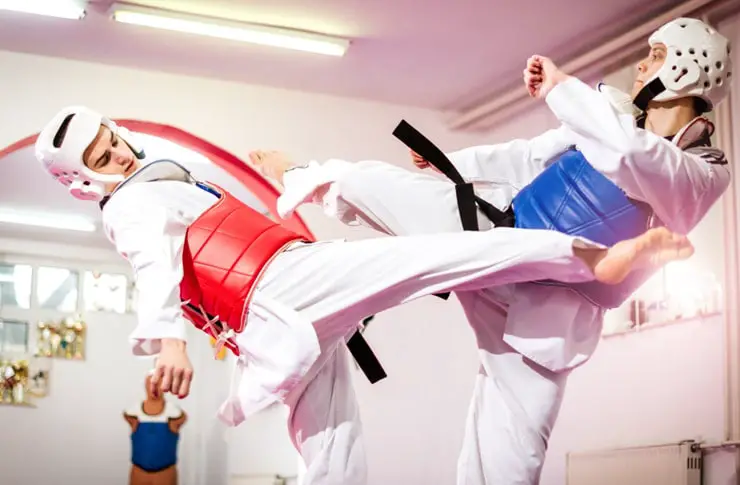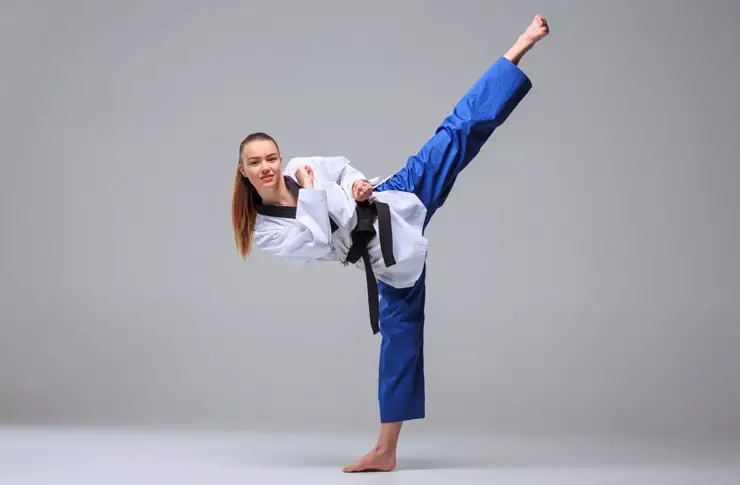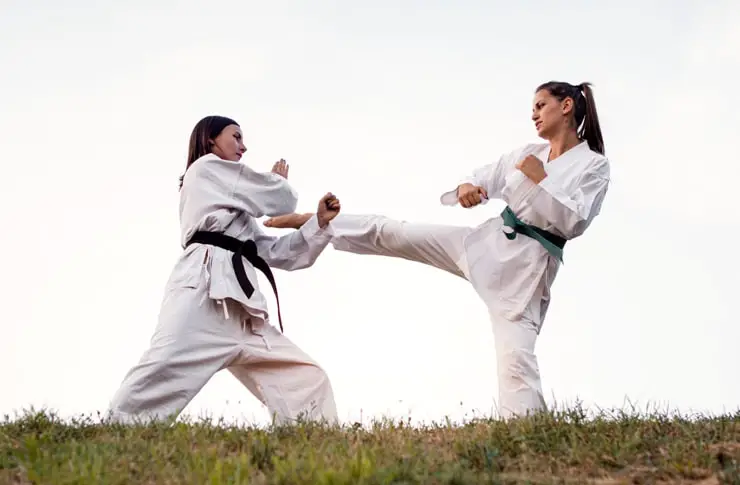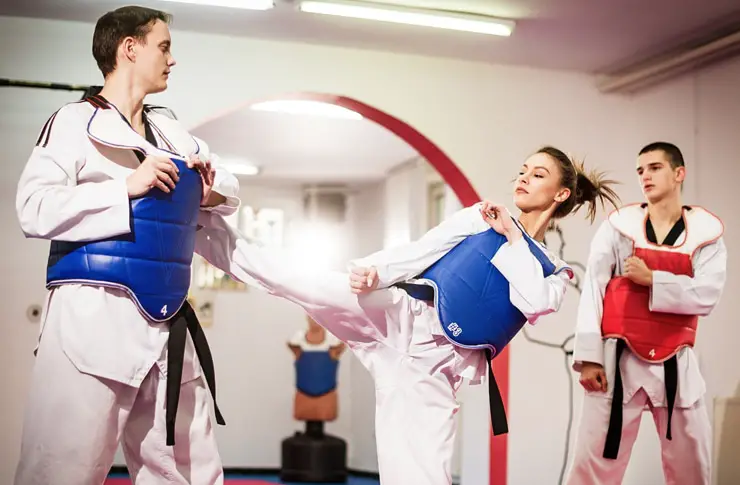
Introduction to Taekwondo
In this article, we’re talking about one of the most essential tools in the taekwondo toolbox – the kick.
Taekwondo is a martial arts discipline that makes heavy use of strikes and kicks. In fact, the word actually translates to “kicking,” “punching,” and “the art” or “way of.” Therefore, the kick and the punch are two of the most important techniques in mastering taekwondo, and we’re taking focus on the former in this article.
In the following section, we’re outlining 12 basic kicks that you can expect to learn as you advance through your training in taekwondo. After that, we’ll take a brief look at advanced techniques and kicks.
Kicks
Kicks are generally considered the most powerful offensive attacks in a taekwondo athlete’s arsenal. This is because the legs are capable of generating an enormous amount of power. With proper technique, a kick can generate enough force to overpower an opponent.
That being said, kicks can also be quite a bit more difficult to pull off in combat. Kicks are generally slower to perform than strikes and can leave you more exposed to counterattacks and blocks. For this reason, many different kicks that have been developed offer different ranges of power, accuracy, and speed. Here are some of the more popular taekwondo kicks:
12 Basic Kicks
As a beginner to taekwondo, you can expect to learn several, if not all, of these kicks. They are popular for their practicality and have become standard weapons in a taekwondo arsenal.
Front Kick (Ap Chagi)
The front kick is perhaps the most popular kick in taekwondo. It is also among the simplest, so it will be one of the first kicks that you learn. This being said, it demonstrates the fact that sometimes the simplest movements are the most effective.
A front kick is performed by facing forward, raising the knee to the waist, and quickly snapping the foot at a target. Because it is such a simple movement, it can be executed quite quickly, making it very versatile and applicable for everyone from beginners to taekwondo masters.
Side Kick (YeopChagi)

The sidekick is known for its power. It utilizes the body’s mechanics to create a force that is quite formidable when mastered. To perform the sidekick, the kicker will rotate their body while raising their front knee. They will use this rotation to power their leg’s extension into a very powerful kick, striking with the outside edge of the foot or the heel.
Because of the extra motion involved, the sidekick is less efficient than the front kick, which demonstrates the fact that taekwondo is often a trade-off between power and efficiency. Experienced practitioners need to read the situation to know which kick is appropriate.
Back Kick (DwitChagi)
The back kick begins by turning the body away from the opponent. This turn is used to generate a lot of force to bring the body into the kicking motion. While turning, the practitioner will kick the back leg straight at the target, making contact with the heel. With practice, this kick can be quite powerful, but it takes effort and precision to master the turn and make contact.
Round House Kick (DollyeoChagi)
The roundhouse kick’s popularity has transcended taekwondo itself, asyou’ve probably seen it utilized in popular movies and TV shows. But the roundhouse kick is more than just flair – it is actually a very effective kick when mastered. The roundhouse kick uses the power of rotation to generate ample torque, making it one of the most powerful kicks available.
To perform a roundhouse kick, the athlete will pivot on their non-kicking foot, generating momentum while extending their opposite foot to make contact with the ball or inside of their foot. The roundhouse is difficult to pull off in sparring because it requires a lot of time to set up properly. That being said, taekwondo masters who are able to use it in combat could potentially overpower an opponent in a single move.
Reverse Side Kick (BandaeYeopChagi)
The reverse side kick is performed by turning the body away from the opponent. Similar to the back kick, the power is generated through this turn, but the reverse side kick involves more rotation. This extra rotation generates even more power through the kick, and the practitioner turns to the point where their body is set up for a side kick, striking with the foot extending from the side of the body.
The reverse sidekick is more powerful than the back kick, but the extra rotation makes it more difficult to make accurate contact, not to mention to stay balanced.
Inner Crescent Kick (An Chaggi)
The crescent kick is named for the “crescent” motion made by the feet during the kick. The inner crescent kick begins with raising the leg high in front of your body and extending it. Following this, the practitioner will sweep the leg in a “crescent” motion toward the inside of their body, making contact with the target.
Outer Crescent Kick (BakkatChagi)

The outer crescent kick is the same principle as the inner crescent kick, but instead of sweeping the foot inward, it is swept outward to make contact with a target away from the body.
Hook Kick or Whip Kick (HuryeoChagi)
The hook kick is largely popular for its deceptive nature. The kick appears initially to miss the target to the side before “hooking” back to make contact. This has made the hook kick popular in sparring and competition.
To do a hook kick, the practitioner raises their leg high, with the heel positioned slightly to the side of the intended target. The practitioner then snaps the foot back at the target, striking them with their heel.
Axe Kick (NaeryoChagi)
The axe kick uses a high leg motion and is used to strike an opponent’s clavicle, head, or upper body.To perform an axe kick, the practitioner stands facing the target and raises their rear leg as high as possible (they can also raise the front leg). Once raised, they snap the leg back down, creating a downward momentum meant to bring the kick down on top of an opponent. It’s similar to the swinging of an axe, hence the name.
An axe kick is meant to strike with the ball of the heel, where the hard bone creates a heavy force. An effective axe kick requires great flexibility, allowing the practitioner to raise the leg as high as possible and increasing the potential downward force created.
Push Kick (Front Thrust Kick)
A push kick is just what the name implies; it’s used to “push” the attacker and move them off-balance to create space. If an attacker is too close to the practitioner, a push kick can be very useful.
A push kick is performed by taking a slight hop forward to generate momentum and extending a quick front kick, striking the opponent with the base of your foot. It is similar to a quick, thrusting front kick, and is valuable for quick strikes in a tight area.
Reverse Turning Kick (BandaeDollyeoChagi)
The reverse turning kick is performed with a half-rotation to generate power. Then, the practitioner will extend their leg forward, making contact with their heel. The force is generated from the “turn,” and the connection is made with a straight leg.
Here’s a great video that demonstrates basic Taekwondo kicks.
Why Basic Kicks?
The above kicks are considered “basic” kicks in many taekwondo schools, and they might be among the first kicks you learn when training in taekwondo. That being said, “basic” does not mean ineffective. It is often the case that basic movements are actually the most effective tools at a martial artist’s disposal. The reason for this is that these movements were created to efficiently utilize the body’s mechanics. They are meant as quick, efficient movements that generate the most power in the least amount of time. As a result, they are simple to learn but difficult to master.
Many of these kicks’ simplicity allows them to be performed in very tight time windows. In a competition or sparring setting, you need to execute moves near immediately. This is especially true for kicks, which are timelier to set up than strikes.
Advanced Kicks

Of course, the above list is not extensive. Taekwondo kicks can become quite advanced. More advanced taekwondo kicks tend to use more rotation, movement, and often utilize jumping.
Many advanced kicks involve the practitioner jumping before performing the kick. The jump creates extra power as well as forward momentum that is carried into the kick. Many jump kicks utilize the same principles as the kicks above but are performed in mid-air. There is a jumping side kick, back kick, roundhouse kick, and much more.
Taekwondo experts take it even further and add a spin motion to their jump kick. Taekwondo kicks can have up to 720 degrees of mid-air rotation, but it goes without saying that these kicks require quite a lot of athleticism.
Certain advanced kicks are quite useful in a competitive or sparring setting. However, certain advanced kicks are most useful for demonstrative purposes.
Conclusion
Thanks for reading our basic guide to taekwondo kicks. As you can see, this is a very extensive area of popular martial art. Basic kicks form the foundation for your progression through taekwondo. Mastering the fundamentals will pave the way toward more advanced movements and skillsets. And don’t forget that kicks are only one aspect of a taekwondo practitioner’s move set. Taekwondo is an extensive martial art, and also makes heavy use of strikes, blocks, and more. Don’t forget, sometimes the most simple movements are the most effective.
